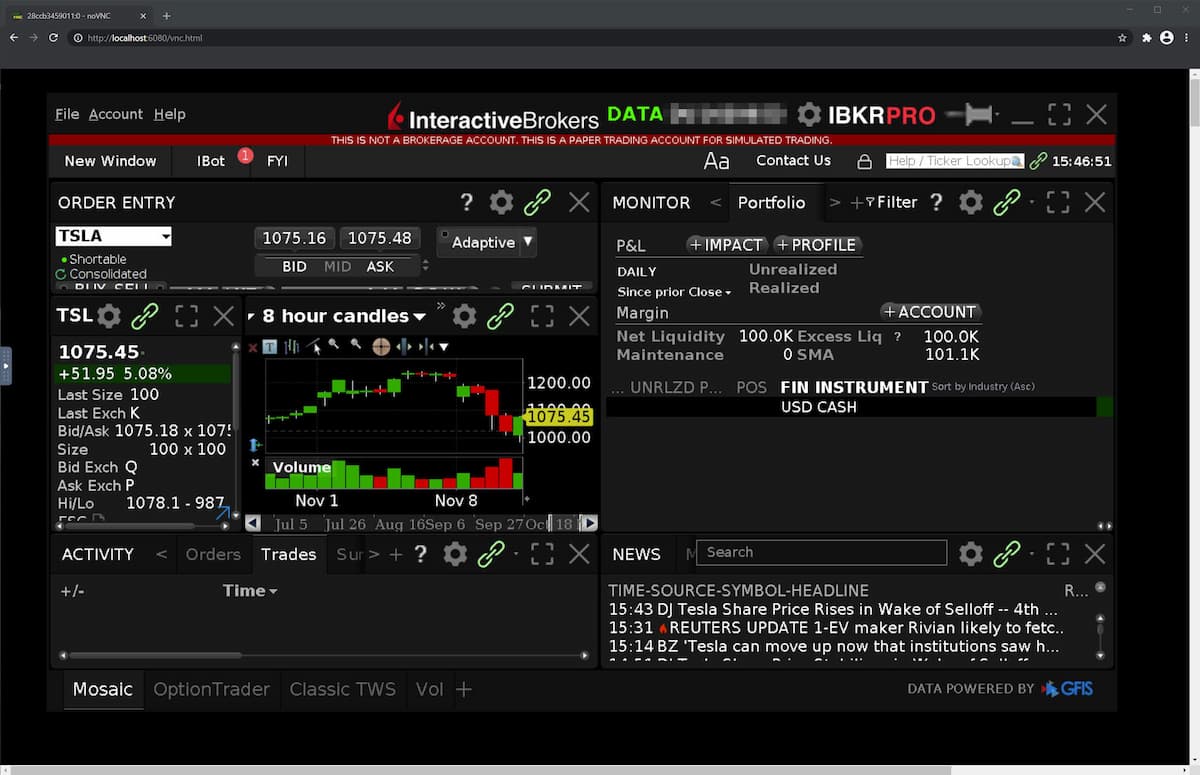- Interactive Brokers in Docker
- Features
- Getting Started
- Docker Images
- FAQ
- How do I save TWS settings locally?
- Cannot connect to API when using TWS
- Error:
library initialization failed - unable to allocate file descriptor table - out of memory/root/ibc/scripts/ibcstart.sh - Which tag to use,
latestorstable? - What is the difference between IB Gateway and Trader Workstation (TWS)?
- Do I need to download TWS separately?
- What ports does TWS/IB Gateway use internally?
- How do I configure the default login to paper/live trading?
- Repository Architecture
Trader Workstation
IB Gateway
- Fully containerized TWS/IB Gateway, no external dependencies
- TWS API access automatically configured and forwarded
- Viewable in a browser (via noVNC)
- Auto-restart, auto-login TWS/IB Gateway automatically via IBC Alpha
docker run -d \
-p "127.0.0.1:6080:6080" \
-p "127.0.0.1:8888:8888" \
--ulimit nofile=10000 \
-e USERNAME=your_username \
-e PASSWORD=your_password \
ghcr.io/extrange/ibkr:latestCreate a .env file:
USERNAME=<your IBKR username>
# wrap password in single quotes if $, /, or \ are present
PASSWORD='<your IBKR password>'compose.yml:
---
services:
ibkr:
image: ghcr.io/extrange/ibkr # latest, stable, 10.21, 10.21.1p etc
ports:
- "127.0.0.1:6080:6080" # noVNC browser access
- "127.0.0.1:8888:8888" # API access
ulimits:
nofile: 10000 # See FAQ
environment:
USERNAME: ${USERNAME}
PASSWORD: ${PASSWORD}
# TWOFA_TIMEOUT_ACTION: restart
# GATEWAY_OR_TWS: tws
#
# Variables prefixed with IBC_ override IBCAlpha`s config.ini:
# IBC_TradingMode: live
# IBC_ReadOnlyApi: yes
# ...
# See below for more detailsImportant: Boolean-like values (e.g. yes/no) must be wrapped in single quotes to prevent them from being interpreted as True/False by th YAML parser.
View at localhost:6080.
TWS API is accessible at port 8888.
| Variable | Description | Default |
|---|---|---|
USERNAME |
Username | edemo |
PASSWORD |
Password | demouser |
GATEWAY_OR_TWS |
What to start, either tws or gateway |
tws |
TWOFA_TIMEOUT_ACTION |
2FA timeout action. Either restart or exit. |
restart |
TWS_SETTINGS_PATH |
(optional) Path to store TWS settings (see FAQ) |
Variables prefixed with IBC_ will override settings in IBCAlpha's config.ini, e.g.:
IBC_TradingMode(default:live)IBC_ExistingSessionDetectedAction(default:manual)IBC_ReadOnlyApi(default: keep existing)- etc.
See possible values here.
See available tags and versions here.
If you want to save TWS settings locally (e.g. to persist settings across container runs), set TWS_SETTINGS_PATH to say, /settings. Then, add a bind mount on your local filesystem, such as in the following compose.yml:
#...
environment:
TWS_SETTINGS_PATH: /settings
#...
volumes:
- ./settings:/settings:rwNow, TWS will load settings from your local filesystem for each container run.
You will need to manually enable Enable ActiveX and Socket Clients (see this issue).
Error: library initialization failed - unable to allocate file descriptor table - out of memory/root/ibc/scripts/ibcstart.sh
Ensure that you have the appropriate ulimit nofile set: either --ulimit nofile=10000 (docker run) or ulimits: nofile: 10000 (docker compose).
stable is generally preferred as there are less bugs.
TWS is a fully featured trading platform with many features.
IB Gateway has a minimal GUI and is used for API access to the trading platform, for example with automated trading. It also uses less resources.
See here for more differences.
Both the IB Gateway and TWS installation scripts include both IB Gateway and TWS, so downloading either is fine.
TWS uses 7496 (live) and 7497 (paper), while IB gateway uses 4001 (live) and 4002 (paper).
There is no need to change the port for this image, as it automatically forwards the correct port (based on trading mode and TWS/IB Gateway) to 8888.
Set the environment variable IBC_TradingMode to paper or live.
- New versions of IB Gateway are checked for daily, and fetched if available, as a release (
detect-releases.yml). - A PR with the updated
Dockerfile(obtained by runningbuild.sh <latest/stable> <version>) is automatically created - I test the updated configuration (both IB Gateway/TWS)
- I then manually merge the PR, and tag the resulting commit with
git tag docker-<version>-<latest/stable> - Pushing the tag triggers a docker build action (
publish.yml, based on thedocker-prefix), which reads the version and release channel (latest/stable) from the tag, and then fetches the repo at the tag's commit, builds from the appropriate folder (latest/stable), tags and pushes the image to ghcr.io/extrange/ibkr.

